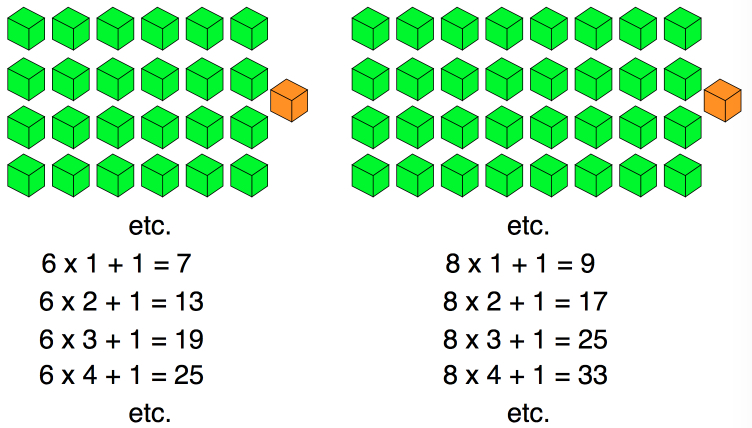Skip over navigation



Or search by topic
Number and algebra
Geometry and measure
Probability and statistics
Working mathematically
Advanced mathematics
For younger learners
Bundles of Cubes
Age 7 to 11
Challenge Level 





In this challenge, we will be making 'bundles' of cubes.
We are going to start by making bundles of four cubes.
In the animation below, we start with one bundle and add an extra cube on its own, making five cubes altogether.
See what happens as we have more bundles and still keep just one extra cube:
We are going to start by making bundles of four cubes.
In the animation below, we start with one bundle and add an extra cube on its own, making five cubes altogether.
See what happens as we have more bundles and still keep just one extra cube:
What do you notice?
Can you explain your noticings?
We could then look at using a bundle of a different size. In the pictures below we see the same idea with bundles of six cubes and eight cubes:

The images above stop at 'four lots' but you could try going much further, maybe up to sixteen lots.
What happens when the bundles are of five, seven or nine cubes?
When you've done some exploring and got some results, then compare your results for the different sizes of bundles.
What do you notice?
Can you explain any of your noticings?
Can you explain your noticings?
We could then look at using a bundle of a different size. In the pictures below we see the same idea with bundles of six cubes and eight cubes:

The images above stop at 'four lots' but you could try going much further, maybe up to sixteen lots.
What happens when the bundles are of five, seven or nine cubes?
When you've done some exploring and got some results, then compare your results for the different sizes of bundles.
What do you notice?
Can you explain any of your noticings?
Related Collections
You may also like
Counting Counters
Take a counter and surround it by a ring of other counters that MUST touch two others. How many are needed?
Cuisenaire Squares
These squares have been made from Cuisenaire rods. Can you describe the pattern? What would the next square look like?
Doplication
We can arrange dots in a similar way to the 5 on a dice and they usually sit quite well into a rectangular shape. How many altogether in this 3 by 5? What happens for other sizes?

